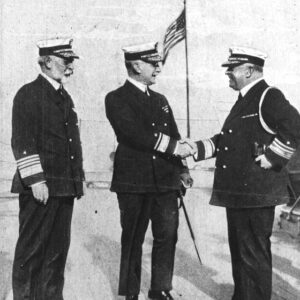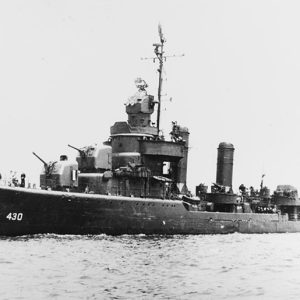calsfoundation@cals.org
Edward Walter Eberle (1864–1929)
Edward Walter Eberle was a U.S. Navy officer who grew up in Fort Smith (Sebastian County) before beginning a forty-seven-year career that saw him develop several innovations and rise to some of the highest naval posts. Two naval ships, the USS Eberle and the USS Admiral E. W. Eberle, have been named in his honor.
Edward Walter Eberle was born on August 17, 1864, in Denton, Texas, to Joseph Eberle and Mary Stemler Eberle, who fled Fort Smith when Union troops threatened to capture the town in 1863. They returned to Fort Smith after the war, and young Edward attended school there before being appointed to the U.S. Naval Academy in September 1881.
After graduating, he served on the USS Albatross, a marine research vessel, where he helped develop the Tanner Sounding Device that was used to help chart fishing waters. Promoted to lieutenant junior grade in 1896, Eberle served as the forward turret commander on the battleship USS Oregon, famed for sailing 14,700 miles around South America to arrive in time to participate in the Battle of Santiago Bay during the Spanish-American War. During the battle, Eberle’s guns helped wreck the Cristóbal Colón, the Spanish navy’s only modern gunboat, and force it to run aground.
He married Tazie Harrison on October 24, 1899, and the couple had one son, who would himself become a naval officer. That same year, Eberle was promoted to first lieutenant and served as Admiral Albert S. Barker’s acting chief of staff of the Asiatic Station at Manila in the Philippines; while at this post, he developed the drill procedures manual for the use of modern guns and torpedoes. From 1903 to 1905, he served as flag lieutenant under Barker in the U.S. Fleet, Atlantic, where he wrote the first manual for the navy’s use of wireless communications. Eberle was then sent to the War College before becoming commander of the San Francisco Naval Training Station, serving from 1909 to 1910.
Eberle then commanded the cruiser USS Wheeling on a two-year voyage around the world before being promoted to captain and taking command of the new Atlantic Torpedo Fleet in 1912. In this position, he promoted the use of airplanes to locate and sink submarines and also developed smoke-screen tactics. As commander of the USS Washington in 1914, Eberle helped establish a blockade around the Dominican Republic to crush a rebellion there.
In 1915, he was appointed superintendent of the U.S. Naval Academy, where he worked to restore the scandal-plagued institution’s reputation while shortening the period in which midshipmen were trained in order to provide naval personnel during World War I. He received the Distinguished Service Medal in 1918 for his efforts at Annapolis and was promoted to rear admiral the next year. Eberle then commanded divisions of the Atlantic Fleet for two years, followed by command of divisions in the Pacific Fleet from 1921 to 1923. In 1923, he became Chief of Naval Operations—the highest shore position in the Navy—and advised President Calvin Coolidge during unrest in China and Nicaragua. Eberle was pictured on the cover of Time magazine on February 4, 1924. He was appointed as head of the executive committee of the Navy General Board in 1927 and served in that post until reaching the mandatory retirement age on August 17, 1928, ending his forty-seven-year career with the temporary rank of full admiral and as the senior ranking officer in the U.S. Navy.
Eberle had suffered an injury to his ear in an accident while on duty in 1910. His ear never healed, and an infection of the wound led to his death on July 6, 1929. The Arkansas Gazette remembered him in an article on his passing as “a small grey bearded man…noted for his firmness, yet…beloved by officers and enlisted men alike for his kindness, and…respected for his calm judgment and wise decisions.” He is buried at Arlington National Cemetery.
For additional information:
“Admiral Eberle Dies in Washington.” Arkansas Gazette, July 7, 1929, p. 19.
“Edward Walter Eberle.” Arlington National Cemetery (Unofficial Site). http://www.arlingtoncemetery.net/eweberle.htm (accessed January 16, 2019).
Spears, Jim. “Fort Smith’s Admirals: Eberle and Cooke.” Journal of the Fort Smith Historical Society 33 (April 2009): 32–37.
Mark K. Christ
Little Rock, Arkansas
 Bumpers, Betty
Bumpers, Betty Military
Military Edward Walter Eberle
Edward Walter Eberle  Edward Walter Eberle
Edward Walter Eberle  USS Admiral E. W. Eberle
USS Admiral E. W. Eberle  USS Eberle
USS Eberle 




Comments
No comments on this entry yet.